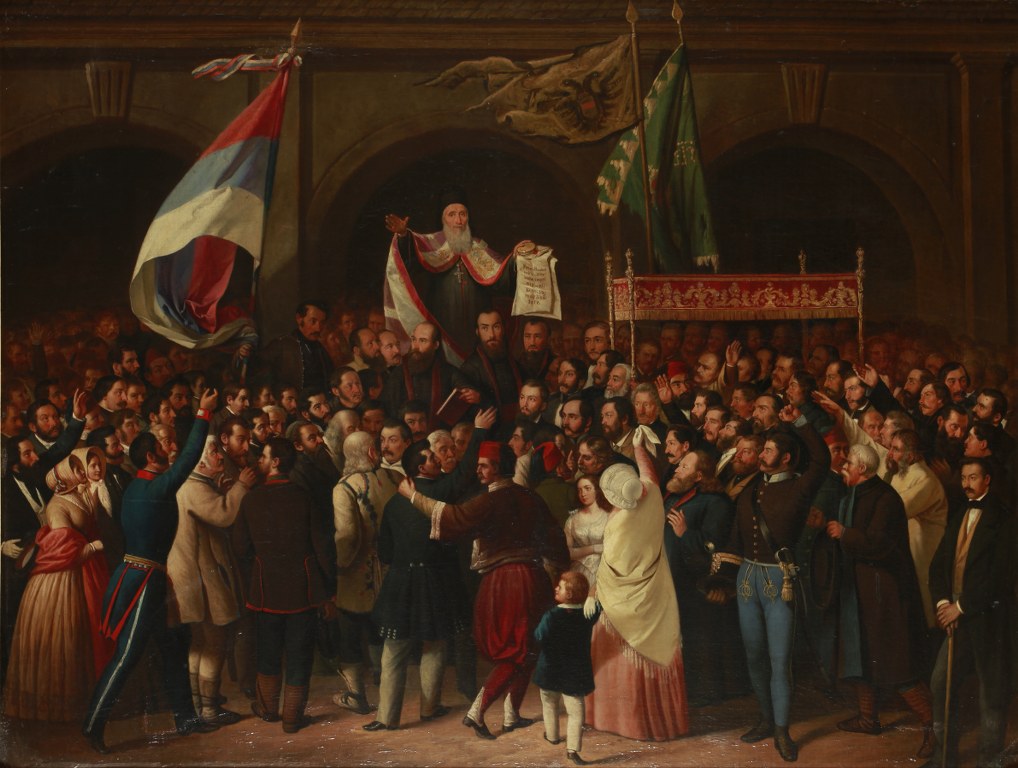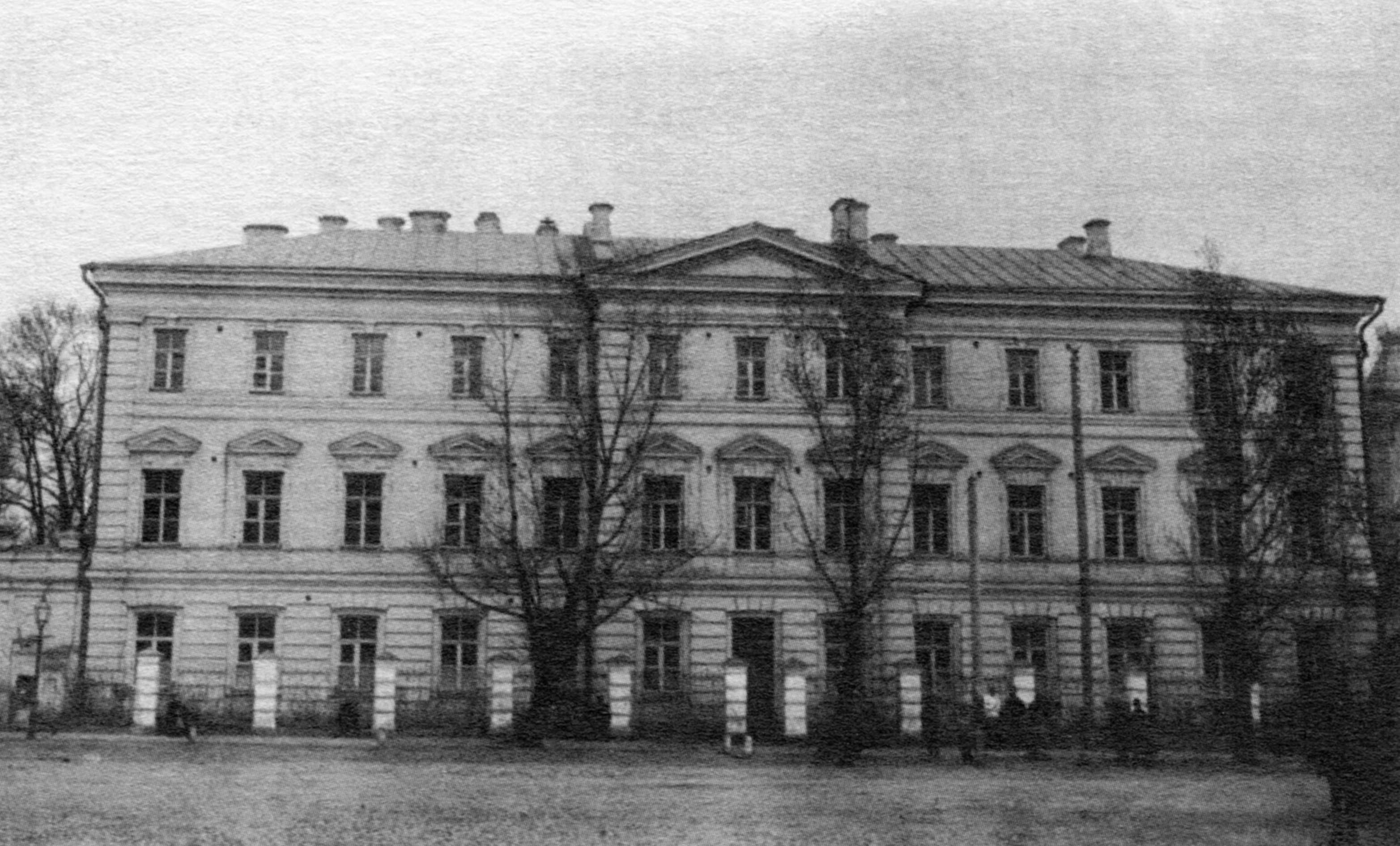|
Germogen Maximov
Metropolitan Germogen (), secular name Georgy Ivanovich Maximov, (; 10 January 1861 – 30 June 1945) was bishop of Aksay (9 May 1910 – 1919), Vicar of the Don Diocese, 23rd Bishop of Yekaterinoslav and Novomoskovsk (1919 – November 1920), Governor of the Russian Orthodox municipalities on Crete and North Africa with a seat in Athens (1922), Archbishop of Yekaterinoslav and Novomoskovsk (ROCOR, titular) (1922–1942), member of the Synod of Bishops of the Russian Orthodox Church Abroad (1924–1942), the head (Patriarch or Metropolitan) of the Croatian Orthodox Church (1942–1945). Early life Georgy Ivanovich Maximov was born in 1861 in Stanitsa Nogavskaya in the Don Host Oblast of the Russian Empire to a Cossack family. His father was a church reader (Russian: псаломщик). He finished elementary and parochial school in Nogavskaya and high school in Ust-Medvedicka. He studied from 1879 to 1882, in the Don Theological Seminary in Novocherkassk, and then attende ... [...More Info...] [...Related Items...] OR: [Wikipedia] [Google] [Baidu] |
Sremski Karlovci
Sremski Karlovci ( sr-Cyrl, Сремски Карловци, ) is a town and municipality located in the South Bačka Districtautonomous province of Vojvodina, Serbia. It is situated on the banks of the Danube, from Novi Sad. According to the 2022 census results, it has a population of 7,872 inhabitants. The town has traditionally been known as the seat of the Patriarchate of Karlovci, Serbian Orthodox Church in the Habsburg Monarchy. It was the political and cultural capital of Serbian Vojvodina after the May Assembly and during the Revolution in 1848. Name In Serbian language, Serbian, the town is known as ''Sremski Karlovci'' (Сремски Карловци), in Croatian language, Croatian as ''Srijemski Karlovci'', in German language, German as ''Karlowitz'' or ''Carlowitz'', in Hungarian language, Hungarian as ''Karlóca'', in Polish language, Polish as ''Karłowice'', in Romanian language, Romanian as ''Carloviț'' and in Turkish language, Turkish as ''Karlofça''. The form ... [...More Info...] [...Related Items...] OR: [Wikipedia] [Google] [Baidu] |
Stanitsa
A stanitsa or stanitza ( ; ), also spelled stanycia ( ) or stanica ( ), was a historical administrative unit of a Cossack host, a type of Cossack polity that existed in the Russian Empire. Etymology The Russian word is the diminutive of the word (), which means "station" or "police district". It is distantly related to the Sanskrit word (), which means "station", "locality", or "district". Structure The stanitsa was a unit of economic and political organisation of the Cossack peoples who lived in the Russian Empire. Each stanitsa contained several villages and khutirs. An assembly of landowners governed each stanitsa community. This assembly distributed land, oversaw institutions like schools, and elected a stanitsa administration and court. The stanitsa administration consisted of an Ataman, a collection of legislators, and a treasurer. The stanitsa court made judgements regarding "petty criminal and civil suits". All inhabitants, except for non-Cossacks, were considered me ... [...More Info...] [...Related Items...] OR: [Wikipedia] [Google] [Baidu] |
October Revolution
The October Revolution, also known as the Great October Socialist Revolution (in Historiography in the Soviet Union, Soviet historiography), October coup, Bolshevik coup, or Bolshevik revolution, was the second of Russian Revolution, two revolutions in Russia in 1917. It was led by Vladimir Lenin's Bolsheviks as part of the broader Russian Revolution of 1917–1923. It began through an insurrection in Petrograd (now Saint Petersburg) on . It was the precipitating event of the Russian Civil War. The initial stage of the October Revolution, which involved the assault on Petrograd, occurred largely without any casualties. The October Revolution followed and capitalized on the February Revolution earlier that year, which had led to the abdication of Nicholas II and the creation of the Russian Provisional Government. The provisional government, led by Alexander Kerensky, had taken power after Grand Duke Michael Alexandrovich of Russia, Grand Duke Michael, the younger brother of ... [...More Info...] [...Related Items...] OR: [Wikipedia] [Google] [Baidu] |
Saint Petersburg
Saint Petersburg, formerly known as Petrograd and later Leningrad, is the List of cities and towns in Russia by population, second-largest city in Russia after Moscow. It is situated on the Neva, River Neva, at the head of the Gulf of Finland on the Baltic Sea. The city had a population of 5,601,911 residents as of 2021, with more than 6.4 million people living in the Saint Petersburg metropolitan area, metropolitan area. Saint Petersburg is the List of European cities by population within city limits, fourth-most populous city in Europe, the List of cities and towns around the Baltic Sea, most populous city on the Baltic Sea, and the world's List of northernmost items#Cities and settlements, northernmost city of more than 1 million residents. As the former capital of the Russian Empire, and a Ports of the Baltic Sea, historically strategic port, it is governed as a Federal cities of Russia, federal city. The city was founded by Tsar Peter the Great on 27 May 1703 on the s ... [...More Info...] [...Related Items...] OR: [Wikipedia] [Google] [Baidu] |
Archimandrite
The title archimandrite (; ), used in Eastern Christianity, originally referred to a superior abbot ('' hegumenos'', , present participle of the verb meaning "to lead") whom a bishop appointed to supervise several "ordinary" abbots and monasteries, or as the abbot of some especially great and important monastery. In the Eastern Orthodox Church and the Eastern Catholic Churches, "archimandrite" is most often used purely as a title of honor (with no connection to any actual monastery) and is bestowed on a hieromonk as a mark of respect or gratitude for service to the Church. This title is only given to those priests who have been tonsured monks, while distinguished non-monastic (typically married) priests would be given the title of protopresbyter. In history, some women were able to obtain that title, notably when cross-dressing as male monks, such as Susanna the Deaconess. History The term ' derives from the Greek: the first element from ''archi-'' meaning "highest" ... [...More Info...] [...Related Items...] OR: [Wikipedia] [Google] [Baidu] |
Monk
A monk (; from , ''monachos'', "single, solitary" via Latin ) is a man who is a member of a religious order and lives in a monastery. A monk usually lives his life in prayer and contemplation. The concept is ancient and can be seen in many religions and in philosophy across numerous cultures. The Greek word for "monk" may be applied to men or women. In English, however, "monk" is applied mainly to men, while ''nun'' is typically used for female monastics. Although the term ''monachos'' is of Christianity, Christian origin, in the English language ''monk'' tends to be used loosely also for both male and female ascetics from other religious or philosophical backgrounds. However, being generic, it is not interchangeable with terms that denote particular kinds of monk, such as cenobite, hermit, anchorite, or Hesychasm, hesychast. Traditions of Christian monasticism exist in major Christian denominations, with religious orders being present in Catholicism, Lutheranism, Oriental Ort ... [...More Info...] [...Related Items...] OR: [Wikipedia] [Google] [Baidu] |
Saratov
Saratov ( , ; , ) is the largest types of inhabited localities in Russia, city and administrative center of Saratov Oblast, Russia, and a major port on the Volga River. Saratov had a population of 901,361, making it the List of cities and towns in Russia by population, 17th-largest city in Russia by population. Saratov is north of Volgograd, south of Samara, and southeast of Moscow. The city stands near the site of Ukek, Uvek, a city of the Golden Horde. Tsar Feodor I of Russia likely developed Saratov as a fortress to secure Russia's southeastern border. Saratov developed as a shipping port along the Volga and was historically important to the Volga Germans, who settled in large numbers in the city before they were expelled before and during World War II. Saratov is home to a number of cultural and educational institutions, including the Saratov Drama Theater, Saratov Conservatory, Radishchev Art Museum, Saratov State Technical University, and Saratov State Univ ... [...More Info...] [...Related Items...] OR: [Wikipedia] [Google] [Baidu] |
Rector (ecclesiastical)
A rector is, in an ecclesiastical sense, a cleric who functions as an administrative leader in some Christian denominations. In contrast, a vicar is also a cleric but functions as an assistant and representative of an administrative leader. Ancient usage In ancient times bishops, as rulers of cities and provinces, especially in the Papal States, were called rectors, as were administrators of the patrimony of the Church (e.g. '). The Latin term ' was used by Pope Gregory I in '' Regula Pastoralis'' as equivalent to the Latin term ' (shepherd). Roman Catholic Church In the Roman Catholic Church, a rector is a person who holds the ''office'' of presiding over an ecclesiastical institution. The institution may be a particular building—such as a church (called his rectory church) or shrine—or it may be an organization, such as a parish, a mission or quasi-parish, a seminary or house of studies, a university, a hospital, or a community of clerics or religious. ... [...More Info...] [...Related Items...] OR: [Wikipedia] [Google] [Baidu] |
Vladikavkaz
Vladikavkaz, formerly known as Ordzhonikidze () or Dzaudzhikau (), is the capital city of North Ossetia–Alania, Russia. It is located in the southeast of the republic at the foothills of the Caucasus, situated on the Terek (river), Terek River. The city's population was 295,830 as of the 2021 Russian census, 2021 Census. As a result, Vladikavkaz is one of the most populous cities in the North Caucasus region. The city is an Industrial sector, industrial and transport, transportation centre. Manufactured products include processed zinc and lead, machinery, chemical substance, chemicals, clothing and food products. Etymology The name ''Vladikavkaz'', derived from the Russian language, literally means "ruler of the Caucasus". The Ossetian name Dzæwdžyqæw/Dzæwægighæw literally means " settlement". In 1911, wrote that the Ossetians prove that fortress was founded on the site of the Ingush village Zaur (village), Zaur by the name of Vladikavkaz in the Ossetian language: In ... [...More Info...] [...Related Items...] OR: [Wikipedia] [Google] [Baidu] |
Kiev Theological Academy
The Kiev Theological Academy (1819—1919) was one of the oldest higher educational institution of the Russian Orthodox Church, situated in Kiev, then in the Russian Empire (now Kyiv, Ukraine). It was considered as the most senior one among similar academies in Moscow, Saint Petersburg, and Kazan. It was located at the Kiev Podol within the Kiev Epiphany Monastery. In the Russian historiography, the Academy′s predecessor was the Academia Mohileana that was founded earlier in the 17th century. History Predecessor Collegium Mohileanum in Kiev The Kiev Theological Academy traces its history back to 1615, when Yelisey Pletenetsky founded a school at the Brotherhood Monastery in Kiev. Several decades later, Peter Mohyla, from 1632 an Orthodox Metropolitan of Kiev under the Patriarchate of Constantinople, merged it with a newly established Lavra school into the Mohyla Collegium (Latin: Collegium Kijovense Mohileanum). The Collegium alumni include Innokentiy Gizel, Lazar Ba ... [...More Info...] [...Related Items...] OR: [Wikipedia] [Google] [Baidu] |
Kiev
Kyiv, also Kiev, is the capital and most populous List of cities in Ukraine, city of Ukraine. Located in the north-central part of the country, it straddles both sides of the Dnieper, Dnieper River. As of 1 January 2022, its population was 2,952,301, making Kyiv the List of European cities by population within city limits, seventh-most populous city in Europe. Kyiv is an important industrial, scientific, educational, and cultural center. It is home to many High tech, high-tech industries, higher education institutions, and historical landmarks. The city has an extensive system of Transport in Kyiv, public transport and infrastructure, including the Kyiv Metro. The city's name is said to derive from the name of Kyi, one of its four legendary founders. During History of Kyiv, its history, Kyiv, one of the oldest cities in Eastern Europe, passed through several stages of prominence and obscurity. The city probably existed as a commercial center as early as the 5th century. A Slav ... [...More Info...] [...Related Items...] OR: [Wikipedia] [Google] [Baidu] |






